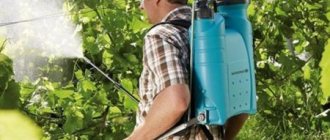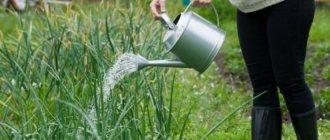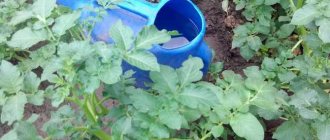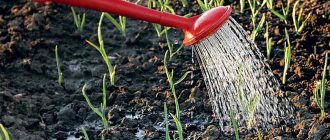How often to water roses
It is difficult to give a definite answer here - it depends on many factors. First of all, it depends on the regularity of rain. If they occur at least once a week, then additional watering can be abandoned altogether. You should also take into account the weather - on hot days with strong winds, you need to water your favorite garden more often than on cool, calm ones.
Watering roses is a whole science
Fact! There is no need to water roses often - it is better to do it less often, spending more water, saturating the soil to a greater depth.
We must not forget about the characteristics of the soil - on heavy soils (clayey, loamy) water stagnates longer than on light soils (sandy). This criterion should also be taken into account.
Caring for indoor roses
You should start caring for the plant immediately after purchase, for which use the following tips:
- If the rose does not bloom, then first you should wash it, directly under the shower with warm water. This will help wash away dirt, hazardous chemicals, and pests.
- After this, the plant is transplanted into a suitable pot and into fertile soil. Again, if an indoor rose is blooming, then you should wait to replant, otherwise the flowering process will stop.
- As a preventive measure or to get rid of pests, treat with a special preparation. If traces of fungus are visible, then spray with other means.
- In order for an indoor rose to begin to develop well, your home care needs to include the removal of blackened areas, dry leaves, and so on.
After this, choose a suitable habitat, for example, the plant loves sunny places, but the bushes need to be protected from direct rays of the sun. Being in the shade can cause poor growth and lack of flowering. Proper care of indoor roses involves the use of diffused light. In addition, keep in mind that the flower loves fresh air, so the room should be frequently ventilated. You should not place pots in a common pile of plants, since roses love space. Rotate the flower periodically to keep the bush symmetrical.
How to water an indoor rose at home?
For proper care, you need to know that the plant loves high humidity. The soil should be constantly moist, but do not overwater the flower. The frequency of moistening depends on the time of year, so watering an indoor rose in winter should be reduced, but it cannot be stopped, otherwise the bush will shed all its leaves. If there is water left in the pan after irrigation, it should be drained. It is better to alternate watering methods: once at the root, and the second through a tray. Spray on hot days.
How does an indoor rose propagate?
The best way to propagate this plant is by cuttings. The procedure should be carried out in the summer, and for cuttings you need to choose branches that previously had flowers. They should have no more than 2-3 buds. Propagation of indoor roses is carried out as follows:
- Cut the cuttings so that the bottom cut is oblique and the bud points upward. Leave the top cut straight and it should be slightly higher than the first bud.
- Place the cuttings in water or directly in a substrate that consists of peat and sand. When using liquid, you need to change it regularly and add activated carbon to it.
- Planting of cuttings is carried out when the length of the roots reaches 1-2 cm.
Watering by season
In many ways, the intensity of watering depends on the time of year. On hot summer days, bushes evaporate more moisture than on cool spring or autumn days. In spring, the plant develops more actively than in autumn, but in autumn it prepares for wintering. This means that watering rules are changing. Therefore, it will be useful to consider each season separately in order to get the most complete picture.
in spring
Caring for roses in the summer at the dacha in the open ground
In spring, the buds swell, sap runs through the awakened branches - the plant is preparing to awaken and soon delight its owners with gorgeous flowers. If there is a lack of moisture, there is a high probability that the buds will be small, and their number will be minimal.
Therefore, it is advisable to start watering in mid-April, when the ground has completely warmed up and thawed. There is no need to do this too often - one watering session every 7-10 days is quite enough.
In summer
Summer is the best time of the year when the rose is covered with gorgeous flowers, delighting observers. It will bloom only if ideal conditions are created, including watering.
The intensity of watering is influenced by: weather, soil type, regularity of natural precipitation. But even if it rains regularly, it is important to monitor the condition of the soil. In some cases, weak summer precipitation wets the soil only from above. The lower part, where the root system is located, remains dry.
On a note! It is important to monitor the condition of the plants. Even a novice gardener will be able to determine by appearance that roses lack moisture or some nutrients.
Overfilling is more dangerous than underfilling. The latter is easy to notice - the leaves on the bushes begin to fade, which means that measures should be taken in a timely manner. When there is excess moisture, the root system begins to rot. And sometimes even an experienced florist notices something is wrong too late - at best, the bush has to be replanted in order to save it from death.
Young plants need to be watered especially often
In general, watering roses in summer should be the most intense - the ground under the bushes needs to be moistened so that the plant feels comfortable.
Autumn
In autumn, most roses stop flowering (the only exceptions are some hybrid and tea varieties). But this does not mean that you can forget about watering. Quite the contrary, the plant is actively preparing for winter, and the success of wintering the crop depends on how the owner takes care of it.
About a couple of weeks before the first frost (this depends on the specific region), it is necessary to water the bushes abundantly - 10-15 liters of water for each, and up to 40 liters for climbing ones. This will allow the plants to absorb moisture. Some also add phosphorus fertilizers to strengthen the roots and make wintering easier.
Important! But in general, there is no need to actively water roses in the fall - the heat has already passed and cool days are coming. And regular watering can lead to young shoots appearing on the bushes, which are not only guaranteed to die in the winter, but can also weaken the plant, reducing the likelihood of a successful wintering.
Watering for the winter
Shortly before the onset of frost, the bushes need to be watered abundantly. Thanks to this, the roots will gain enough moisture and nutrients. Then you no longer need to water the bushes. The rose will overwinter better if the soil underneath is relatively dry. And the likelihood of new shoots appearing will be significantly reduced.
Important Tips
- Do not water roses in hot weather; remaining moisture on the leaves and flowers will cause burns;
- Do not water the bushes in the evening - wet leaves and stems may be susceptible to fungal diseases.
If you follow all the rules when watering roses, then after 3 years they will exhibit a new useful quality - drought resistance. During this time, the roots have deepened and developed and can extract water not only from the surface, but also from the depths of the earth.
Water for watering roses
- For irrigation, you need to take tap water that has been standing for at least 2-3 days; this action is required to remove chlorine from the water.
- Rain water has a lower amount of salts and is also suitable, as is river water.
- The water from the well is too cold for irrigation; the roots of the plant cannot completely absorb cold water, therefore, even with wet soil, the bush may begin to experience water starvation.
- The optimal water temperature should be no more than 22 degrees.
- Water with the addition of nettle infusion is beneficial for roses.
Signs of insufficient or excess watering:
- leaves turn yellow;
- leaves fall;
- flowering decreases;
- flowers dry up;
- flowering stops completely;
A gray coating on the ground under the bush indicates excessive watering.
General rules for watering roses
Roses - planting and care in open ground for beginners
Only with proper care will all plantings feel excellent - even seemingly insignificant mistakes can lead to the appearance of diseases or simply a general weakening of the bushes. To prevent this, you should follow the rules.
Creating an earthen roll around the plant
First of all, it is necessary to create a small shaft of earth around the trunk of the bush with a depression in the center. This is necessary to make watering easier. This way, the water will not spread throughout the garden, but will always remain in the right place, actively absorbing and easily reaching the root system, feeding the bush.
Mulch makes maintenance much easier
It is not necessary to make the recess too large - a circle with a radius of 25-30 cm around the trunk is enough. It is recommended to actively mulch this area, especially if you have to work in a dry, hot climate. On the one hand, mulch reduces moisture loss, especially during dry winds, and on the other hand, as it gradually rots, it serves as an excellent fertilizer for the plant.
Dry chopped grass, compost, dry manure, and spruce needles can be used as mulch. But sawdust is not suitable - it changes the acidity of the soil, which can harm the plant. Due to the light color, sawdust reflects the sun's rays, which can cause sunburn on the leaves.
Water quality
Experts believe that the best choice for irrigation is rainwater. To do this, it is recommended to place a barrel in which to collect water that falls on the roof of a house, garage or shed during rain. This solution has many advantages - it is soft water that does not increase the salinity of the soil. In addition, it is obtained completely free of charge - there is no need to pay the meter if the house is connected to the water supply network.
Advice! Drip irrigation uses very little water, and there is no need to waste time on regular flower care.
If this is not possible, then you can water with tap water or well water. But this water needs to be defended. The well liquid will be too cold, and may well freeze the plant, which will lead to its illness or even death. And tap water often contains large amounts of bleach. By holding it for several hours, you can get rid of excess dangerous substances that can harm plants. This happens especially often when grown at home in a pot - due to the small volume of soil, the bush is most easily poisoned.
Soil treatment after watering
This is especially important on hot summer days. The earth is abundantly saturated with water. Moisture penetrates to a considerable depth and nourishes the rose bushes. However, this creates a crust on top. It prevents the passage of air into the ground. And without it, the roots begin to hurt and suffocate, which affects the general condition of the plants.
Spraying will benefit roses growing in a pot.
When a crust forms, it is advisable to loosen the soil not to a great depth. To remove the crust and at the same time not harm the root system, 3-5 cm is enough. With this care, the plant feels great, actively blooms and pleases the owners with gorgeous bouquets.
Optimal time of day for watering
Do not forget about choosing the right time for watering. Experts believe that the best option is morning (before 9 o’clock) or evening (after 7 o’clock). You can also water at night, but this is completely inconvenient due to the darkness.
Why is it not recommended to water during the day? It's simple here - if drops of water get on the leaves, it can cause burns on a sunny day. The sun's rays, passing through the drops, are refracted and concentrated at one point. This is where the burn will appear. A few of these small burns will not cause much harm, but if there are many of them, the plant’s immunity will be undermined, its appearance will deteriorate, and insect pests may well attack the bush.
On a note! It is advisable to water in the evening only in the warm season. If it is already autumn outside with cool nights, then it is better to refuse evening watering. Wet leaves freeze faster in the cold wind, even at above-zero temperatures, which worsens the health of the bush.
How to irrigate a houseplant?
House roses are considered quite whimsical indoor plants, and inexperienced gardeners are often faced with a situation where, instead of a luxurious bright bush, there are only a couple of half-dried twigs in a pot.
But in fact, everything is not as complicated as it seems at first glance, you just need to learn a few important aspects of caring for this plant. Organizing proper watering comes first.
What kind of water is needed?
It is best to water roses with settled (at least 24 hours) or filtered water at room temperature or a little warmer, since cold water will simply freeze the flower. In addition, a disease such as powdery mildew may occur, which will then be very difficult to get rid of. Therefore, water for irrigation should always be prepared in advance.
How much liquid should I use?
The required amount of liquid directly depends on the volume of the pot. The easiest way to calculate how much water is required is by observing the rate of absorption. The pot must be placed in a tray where excess liquid will accumulate. 25-30 minutes after watering, the unabsorbed water must be drained, since long exposure of the roots to waterlogged soil leads to their rotting.
How often should the procedure be performed?
On a note. It is recommended to water domestic roses as the soil dries out, since these ornamental plants are extremely sensitive to lack of moisture.
Depending on the volume of the pot, humidity and air temperature, you can moisten the substrate every 1-2 days, especially during the flowering and growth period, when the rose uses water especially actively.
Water with a watering can or hose
How often to water a cactus: number of times and options at home
Another important question is what is better to water: a hose or a watering can. Using a watering can is considered preferable. In this case, moisture is easily distributed over the entire area of the soil under the bush, without eroding it. But you need to use a special nozzle.
The watering can does not erode the soil
In recent years, the gardening market has offered a variety of hose attachments. When using them, rose bushes can also be watered with a hose. The main thing is that the pressure is not too strong. Otherwise, there is a high probability that the stream of water will wash away the soil, exposing the root system, which will suffer under the rays of the sun. Or the jet will simply break young branches and tear leaves. Therefore, you should be very careful when using the hose.
However, this solution also has an advantage - it is convenient to water the foliage with a hose, which reduces the likelihood of the plant being damaged by spider mites. And this dangerous pest usually appears at low humidity, entangling the leaves with cobwebs and drawing out the juice from them, which leads to the death of the crop.
How to correct the consequences of improper watering?
In most cases, you can save the rose. The first thing you need to understand is what exactly the mistake was. This is not so difficult, because there are only two options - either the plant was not watered enough, or it was regularly watered.
In the first case, it is enough to ensure that the flower begins to receive a sufficient amount of moisture. But it is important not to overdo it, because when the root system is seriously damaged, excess liquid can be detrimental to the rose . If moderate regular watering does not produce results, it makes sense to transplant the plant into new soil, removing damaged areas of the roots.
When a rose suffers from a constant excess of moisture, and traces of mold are already visible on the soil, only an urgent transplant will help. It is very important to completely get rid of the old substrate, remove damaged roots, and treat the remaining ones with a disinfectant (for example, a solution of potassium permanganate). This will help prevent mold from being introduced into the new soil and avoid re-infection.
After transplanting, the rose should be watered moderately but regularly to allow the root system to recover. If a significant part of the roots has been damaged, you can use growth stimulants, for example, root or other similar means.
As you can see, there is nothing complicated in organizing watering a home rose . The main thing is to create comfortable conditions for this beauty, carefully ensure that the soil always remains moist, but do not allow fluid to stagnate. And then it will invariably delight you with bright green foliage and luxurious lush flowers.
Growing a rose at home is not so easy, so you buy a flower in a pot in a store. What kind of care is needed after purchase, why the rose sheds its leaves, buds and dries out, as well as how to properly fertilize and prune the plant - read on our online portal.
Watering rules before and after fertilizing
An experienced gardener applies fertilizing to the soil throughout the warm season - nitrogen in the spring, phosphorus in the fall and potassium throughout almost the entire summer in order to provide the plant with all the substances necessary for active growth, flowering and successful wintering.
Important! Roses in pots need to be watered often, but little by little - water stagnating in the container can lead to rotting of the roots.
If you use fertilizer diluted in water, it is not recommended to water dry soil with it - the effectiveness will significantly decrease. First you need to moisten the soil a little, and after that, water it with diluted fertilizers.
If the gardener prefers dry fertilizing (special long-acting granules are very popular today), then immediately after adding them to the soil, it is advisable to water the roses generously. The bushes will draw moisture from the ground through the root system, absorbing, along with water, beneficial substances that ensure rapid growth.
Of course, caring for roses is quite hard and painstaking work. But the gorgeous flowers with which the plant will thank the owner are certainly worth the effort and time spent.
The importance of regular watering at home
Most indoor roses will grow and bloom well only if they are watered deeply. The soil should remain moist at all times, but it is important that excess water drains freely from the soil through holes in the bottom of the pot.
Reference. If the drainage is not properly organized (there is no drainage layer or holes), it is recommended to replant the plant in compliance with all the rules. Because both excess fluid and lack of it can have a very negative impact on the condition of the rose.
Constant drying out of the soil will lead to damage to the roots , if it affects a large part of the system, even the resumption of regular watering will not be able to save the plant, and it will soon die.
Excessive watering and lack of good drainage lead to stagnation of liquid in the pot, which in turn becomes the main cause of root rot, as well as mold and mildew damage to the soil and the rose itself. A plant that is constantly flooded can either wither or, oddly enough, dry out.
The latter is directly related to damage to the root system - if most of it has died, the flower simply stops receiving water, even if there is enough of it in the soil.
Feeding cucumbers in open ground
During the growing season, cucumbers need to be fed at least 4 times:
- 2 weeks after planting seedlings in open ground.
- During the budding period.
- During the flowering period.
- During the fruiting period.
If you have poor soil or the plant is not developing well, you may need to add additional doses of some microelements.
The first feeding of cucumbers is aimed at helping young plants quickly recover from the stress caused by transplantation and begin to grow. To do this, feed the roots with mineral fertilizers: dilute 20 g of ammonium nitrate and 10 g of potassium sulfate and superphosphate in 10 liters of water. The norm is 1 liter of solution for each bush.
If you are a supporter of organic fertilizers, then add mullein (1:10) or bird droppings (1:20) during this period - they will saturate the soil with nitrogen. And use ash as a source of potassium: dissolve 1 liter of wood ash in 10 liters of water and feed the cucumbers with this solution.
The second feeding of cucumbers is carried out at the budding stage. Here the amount of mineral fertilizers changes: dissolve 40 g of superphosphate, 30 g of ammonium nitrate and 20 g of potassium nitrate in a bucket of water. The application rate for each bush is the same as during the first feeding - 1 liter.
You can water the cucumbers during the period of bud formation with mullein (dilute 0.3-0.5 liters in 10 liters of water) or bird droppings (fill 1 part of the droppings with 20 parts of water, leave for about 5 days). Apply 1 liter of fertilizer to each bush.
The third feeding of cucumbers should stimulate the formation of ovaries on the plants. For this, cucumbers especially need potassium and calcium. There are a lot of these elements in wood ash. The ash infusion is prepared as follows: fill the bucket about a third with ash, add hot water to the top and place in a dark place for two days. After this, strain the solution and pour 0.5 liters of infusion over the cucumbers. After a week and a half, repeat feeding.
To ensure that the ovaries are strong and do not crumble, you can also carry out foliar feeding at this stage. To prepare it, dissolve 30 g of superphosphate in 10 liters of water and spray the bushes with the resulting fertilizer.
The fourth feeding of cucumbers is carried out during the fruiting period and is aimed at the correct formation of the fruit. You can help cucumbers with herbal infusion. Place crushed herbs in a bucket (this can be nettle, wormwood, clover and any other weeds), fill them with warm water and leave for three days. Strain the finished infusion and dilute with water in a ratio of 1:5 before use.
You can replace this fertilizing with a solution of potassium nitrate - dilute 25 g of the drug in 15 liters of water.
How to feed cucumbers in the ground to double the yield. Improper care of cucumbers can ruin the entire harvest. How to prevent this by using fertilizing and fertilizers?
Rules for watering in open areas
Less is better, but more. It is rare but strong watering that promotes better root growth, and not many insignificant ones.
The nozzle on the watering can is important. The water should not flow in one stream, there should be a shower or rain effect. When watering with a hose (with heated water), do not make the water pressure strong so as not to damage the roses. Watering should be done rather slowly, even with short pauses, so that the water has time to be absorbed into the soil and does not stagnate.
Since it is usually cooler at night, it is best to water your roses in the morning to prevent the development of parasites and diseases. It is important to carry out the procedure before the heat sets in. Various types of mold and black spot can develop at night.











